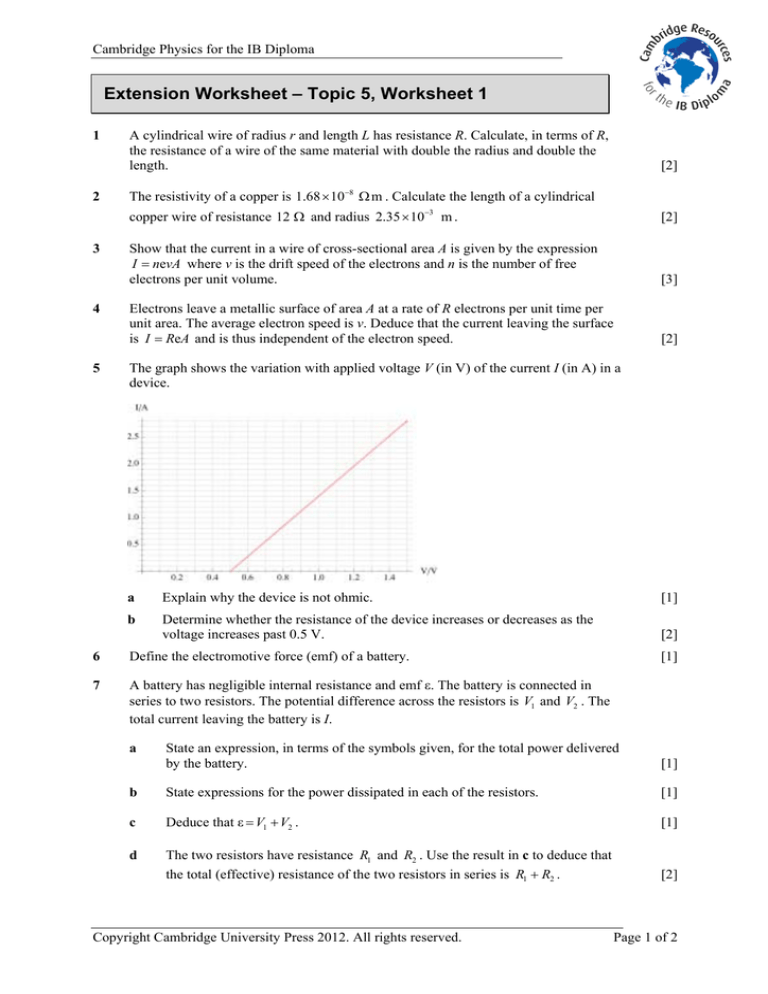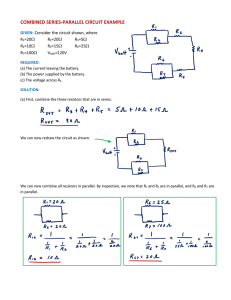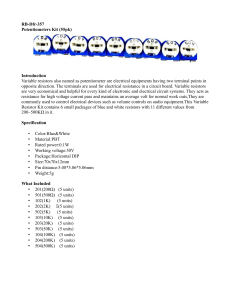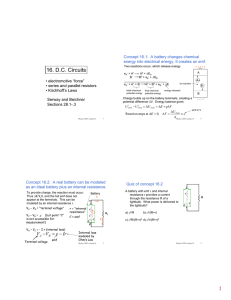
Cambridge Physics for the IB Diploma
Extension Worksheet – Topic 5, Worksheet 1
1
2
3
4
5
A cylindrical wire of radius r and length L has resistance R. Calculate, in terms of R,
the resistance of a wire of the same material with double the radius and double the
length.
[2]
The resistivity of a copper is 1.68 × 10−8 Ω m . Calculate the length of a cylindrical
copper wire of resistance 12 Ω and radius 2.35 × 10−3 m .
[2]
Show that the current in a wire of cross-sectional area A is given by the expression
I = nevA where v is the drift speed of the electrons and n is the number of free
electrons per unit volume.
[3]
Electrons leave a metallic surface of area A at a rate of R electrons per unit time per
unit area. The average electron speed is v. Deduce that the current leaving the surface
is I = ReA and is thus independent of the electron speed.
[2]
The graph shows the variation with applied voltage V (in V) of the current I (in A) in a
device.
a
Explain why the device is not ohmic.
[1]
b
Determine whether the resistance of the device increases or decreases as the
voltage increases past 0.5 V.
[2]
6
Define the electromotive force (emf) of a battery.
7
A battery has negligible internal resistance and emf ε. The battery is connected in
series to two resistors. The potential difference across the resistors is V1 and V2 . The
total current leaving the battery is I.
[1]
State an expression, in terms of the symbols given, for the total power delivered
by the battery.
[1]
b
State expressions for the power dissipated in each of the resistors.
[1]
c
Deduce that ε = V1 + V2 .
[1]
d
The two resistors have resistance R1 and R2 . Use the result in c to deduce that
the total (effective) resistance of the two resistors in series is R1 + R2 .
[2]
a
Copyright Cambridge University Press 2012. All rights reserved.
Page 1 of 2
Cambridge Physics for the IB Diploma
8
9
A battery has negligible internal resistance and emf. The battery is connected in
parallel to two resistors of resistance R1 and R2 .
a
State an expression for the current in each of the resistors.
[1]
b
Deduce that the total (effective] resistance R of the two resistors in parallel is
1 1
1
given by = +
.
R R1 R2
[2]
The current I (in A) in a certain device D varies with applied voltage V (in V) at the
ends of the device according to the graph below.
a
Explain how it may be deduced that the device does not obey Ohm’s law.
[1]
b
Assuming the device is a filament lamp, explain the shape of this graph.
[3]
c
On the same axes draw a graph to show the variation with applied voltage of
the current in another device that has a constant resistance of 25 Ω .
[1]
A battery of emf 0.90 V and negligible internal resistance is connected in series
to the two devices above. Estimate the current leaving the battery.
[2]
d
10
The potential difference across a device is V and the current through it is I.
a
b
State an expression for the work that must be done to move a quantity of charge
Q across the device.
[1]
Use your answer to a to derive an expression for the power dissipated in the
device.
[1]
Copyright Cambridge University Press 2012. All rights reserved.
Page 2 of 2








